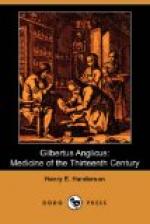The following section, “De inflatione vesice et dolore ejus,” discusses the retention of urine in fevers, and its treatment. Gilbert says: “Inflation of, and pain in the bladder are sometimes symptoms of acute fevers, since the humors descend into and fill the bladder.” If this occurs in an interpolated (remittent) fever, he directs the patient to be placed in a bath of a decoction of pellitory up to the umbilicus, “et effundet urinam.” If the complication occurs in one suffering from a continued fever, the bath should be made of wormwood and a poultice should be placed over the bladder and genitals, “et statim minget.” The same effect may be produced by poultice mixed with levisticum (lovage) or leaves of parsley. Singularly enough the catheter is not mentioned, though this instrument, under the medieval name of argalia (cf. French algalie), is noticed frequently in the section devoted to vesical calculus.
With the second book of the Compendium the system of the discussion of diseases a capite ad pedes is commenced, and produces some curious associates. To the modern physician the sudden transition from diseases of the scalp to fractures of the cranium seems at least abrupt, if not illogical. It seems, therefore, wiser, in a hasty review like the present, to take up the various pathological conditions described by Gilbert in their modern order and relations, and to thus facilitate the orientation of the reader.
The second book then opens with a consideration of the hair and scalp, and their respective disorders.
The hair is a dry fume (fumus siccus), escaping from the body through the pores of the scalp and condensed by contact with the air into long, round cylinders. It increases rather by accretion than by internal growth, and its color depends upon the humors. Thus red hair arises from unconsumed blood or bile; white hair, from an excess of phlegm; black hair, from the abundance of black-bile (melancholia), etc. The use of the hair is for ornament, for protection and for the distinction of the sexes. Numerous prescriptions for dyeing the hair, for depilatories (psilothra), for the removal of misplaced hair and for the destruction of vermin in the hair are carefully recorded.
Three varieties of soaps for medicinal use are described, and the process of their manufacture indicated. The base of each is a lixivium made from two parts of the ashes of burned bean-stalks and one of unslaked lime, mixed with water and strained. Of this base (capitellum), two parts mixed with one part of olive oil form the sapo saracenicus. In the sapo gallicus the base is made with the ashes of chaff and bean-stalks with lime, and to it is added goat’s fat, in place of the oil. The sapo spatareuticus is made in a similar manner, except that oil replaces the goat’s fat and the soap is made only during the dog days, since the necessary heat is to be supplied by the sun alone.




